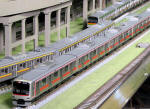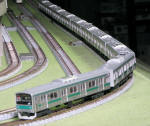N-gauge is a lot like a certain brand of potato chip; you cannot have just one
train. In fact, part of the fun is swapping out one train set for another.
Another is trying to find ways to make the layout larger. I'm constantly
fiddling around with how things are arranged in my basement to see if I can make
more space in order to add to the layout. I'm currently trying to see how to add
another 4x8 foot section. It will require removing the 4x3 foot bit I've added
on since the original layout was started, but I can see how it could be done.
 Meanwhile,
I added another train, this time a Tokyu series
5050-4000 EMU ten car set from Kato that operates on Tokyu's
Toyoko
line. This line runs from Tokyo to Yokohama, hence the name
Toyoko. These trains entered service in September of 2012, making them
relatively new as things go. One thing I have noticed while researching various
trains is that they can easily have a useful life of 40 years or so. Generally
the original operator has them for a while and they are then sold off to
secondary or even tertiary railroads as time goes on.
Meanwhile,
I added another train, this time a Tokyu series
5050-4000 EMU ten car set from Kato that operates on Tokyu's
Toyoko
line. This line runs from Tokyo to Yokohama, hence the name
Toyoko. These trains entered service in September of 2012, making them
relatively new as things go. One thing I have noticed while researching various
trains is that they can easily have a useful life of 40 years or so. Generally
the original operator has them for a while and they are then sold off to
secondary or even tertiary railroads as time goes on.
One of the things that make Japanese passenger trains
so interesting, is not only are there a lot of different designs, but a number
of different colors used on even basically aluminum colored trains. In the photo
for this train you will see three different color combinations. The one nearest
the top is a series 205 that is in what is known as the 'Shonan' color of green
and orange striping. The next train in reddish orange and yellow is also a
series 205, but differs in details from the other 205 EMU in terms of placement
of head and tail lights, for example. Finally, the series 5050-4000 with its
broad red stripe and
 pink trim.
pink trim.
As often happens, an add on set I missed when it first came
out was reissued so I was able to update my Saikyo Line series 205 EMU to a full
ten car set. This is a Kato product.
I also added another
Tobu series 100 'Spacia'
limited express train from Tomix. This one is in Sunny Coral.
 There were actually two
available trains with the other having fine red trim and the color bands not
going through the windows. As my previous series 100 had the color bands through
the windows, I bought the one that matched. Since these trains came in three
colors, the only one I'm missing is the one with purple trim. According to Wiki,
this is the later livery. The earlier livery is shown in the link above. The
photo of the 'Spacia is below.
There were actually two
available trains with the other having fine red trim and the color bands not
going through the windows. As my previous series 100 had the color bands through
the windows, I bought the one that matched. Since these trains came in three
colors, the only one I'm missing is the one with purple trim. According to Wiki,
this is the later livery. The earlier livery is shown in the link above. The
photo of the 'Spacia is below.
 Let's
see, next in the new train department was another Tokyu 5050-4000 operating on
the Toyoko Line, only this time it is in a special livery to celebrate something
or other so is or was very much a one off color. I thought it was a pretty cool
livery and it was, like most of what I buy, at a pretty good discount. This
train is produced by Greenmax and has a different drive system from most others.
The result is that it is quite noisy.
Let's
see, next in the new train department was another Tokyu 5050-4000 operating on
the Toyoko Line, only this time it is in a special livery to celebrate something
or other so is or was very much a one off color. I thought it was a pretty cool
livery and it was, like most of what I buy, at a pretty good discount. This
train is produced by Greenmax and has a different drive system from most others.
The result is that it is quite noisy.
 Another
addition over the last few months has been a freight train. Japan doesn't have
much in the way of rail freight because of its shape and a lot of ports, but
they do exist. Often they run on standard passenger lines. This is an
EF-200
locomotive with a variety of cars. Interestingly, they don't have a caboose, but unlike the US that got rid of them decades ago,
one of the cars always has a small hut on the back of it for a brakeman. This
locomotive is by Kato with cars by Kato and Tomix.
Another
addition over the last few months has been a freight train. Japan doesn't have
much in the way of rail freight because of its shape and a lot of ports, but
they do exist. Often they run on standard passenger lines. This is an
EF-200
locomotive with a variety of cars. Interestingly, they don't have a caboose, but unlike the US that got rid of them decades ago,
one of the cars always has a small hut on the back of it for a brakeman. This
locomotive is by Kato with cars by Kato and Tomix.
 This
next one is a Series
E233-0 by Tomix. It is a ten car train that is operated on the
Chuo line
(rapid). Kato also did one, but has been out of production for a
while so when Tomix released theirs, I picked it up. As usual, one has to buy
three different sets to make a full ten car train. The Chuo Line, which I've
been told means Central Line, is one of the longest lines in Japan.
This
next one is a Series
E233-0 by Tomix. It is a ten car train that is operated on the
Chuo line
(rapid). Kato also did one, but has been out of production for a
while so when Tomix released theirs, I picked it up. As usual, one has to buy
three different sets to make a full ten car train. The Chuo Line, which I've
been told means Central Line, is one of the longest lines in Japan.
There have been a few other bits and pieces to tell about, but
I'll save those for the next update. Hopefully it won't take months to do!
Back to Index
 Meanwhile,
I added another train, this time a Tokyu series
5050-4000 EMU ten car set from Kato that operates on Tokyu's
Toyoko
line. This line runs from Tokyo to Yokohama, hence the name
Toyoko. These trains entered service in September of 2012, making them
relatively new as things go. One thing I have noticed while researching various
trains is that they can easily have a useful life of 40 years or so. Generally
the original operator has them for a while and they are then sold off to
secondary or even tertiary railroads as time goes on.
Meanwhile,
I added another train, this time a Tokyu series
5050-4000 EMU ten car set from Kato that operates on Tokyu's
Toyoko
line. This line runs from Tokyo to Yokohama, hence the name
Toyoko. These trains entered service in September of 2012, making them
relatively new as things go. One thing I have noticed while researching various
trains is that they can easily have a useful life of 40 years or so. Generally
the original operator has them for a while and they are then sold off to
secondary or even tertiary railroads as time goes on. 

